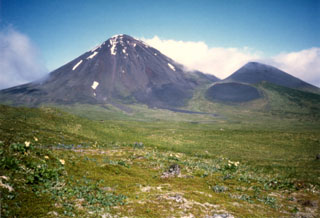Report on Semisopochnoi (United States) — 11 March-17 March 2020
Smithsonian Institution / US Geological Survey
Weekly Volcanic Activity Report, 11 March-17 March 2020
Managing Editor: Sally Sennert.
Please cite this report as:
Global Volcanism Program, 2020. Report on Semisopochnoi (United States) (Sennert, S, ed.). Weekly Volcanic Activity Report, 11 March-17 March 2020. Smithsonian Institution and US Geological Survey.
Semisopochnoi
United States
51.93°N, 179.58°E; summit elev. 1221 m
All times are local (unless otherwise noted)
Seismicity at Semisopochnoi increased over a period of a few days and by 15 March was characterized by nearly continuous tremor and frequent signals indicating small explosions. The unrest prompted AVO to raise the Aviation Color Code to Orange and the Volcano Alert Level to Watch on 15 March. A robust steam plume rising from the N cone of Mount Cerberus and minor ash deposits around the crater rim were visible in a clear satellite image acquired on 16 March.
Geological Summary. Semisopochnoi, the largest subaerial volcano of the western Aleutians, is 20 km wide at sea level and contains an 8-km-wide caldera. It formed as a result of collapse of a low-angle, dominantly basaltic volcano following the eruption of a large volume of dacitic pumice. The high point of the island is Anvil Peak, a double-peaked late-Pleistocene cone that forms much of the island's northern part. The three-peaked Mount Cerberus (renamed Mount Young in 2023) was constructed within the caldera during the Holocene. Each of the peaks contains a summit crater; lava flows on the N flank appear younger than those on the south side. Other post-caldera volcanoes include the symmetrical Sugarloaf Peak SSE of the caldera and Lakeshore Cone, a small cinder cone at the edge of Fenner Lake in the NE part of the caldera. Most documented eruptions have originated from Young, although Coats (1950) considered that both Sugarloaf and Lakeshore Cone could have been recently active.
Source: US Geological Survey Alaska Volcano Observatory (AVO)

